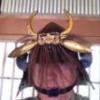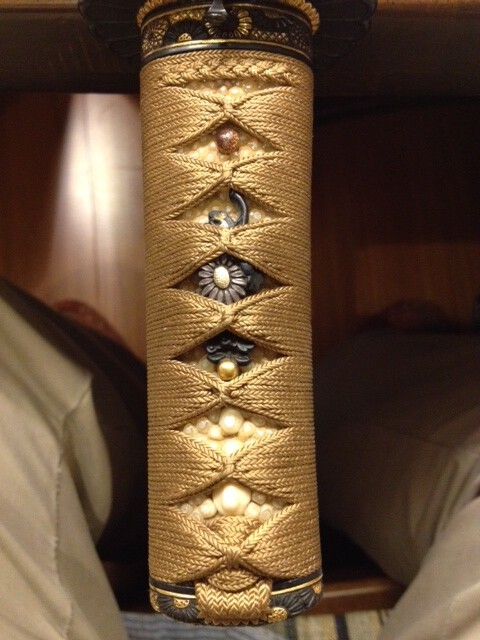-
Posts
13,744 -
Joined
-
Last visited
-
Days Won
247
Content Type
Profiles
Forums
Events
Store
Downloads
Gallery
Everything posted by Bugyotsuji
-
James, this is an explanation of the three positions that the Koshinata (branch lopper which hangs from your belt) is available in, depending on the area in Japan where it is used. In Hokkaido people want to reach up and chop off branches, so the blade opens to a wide angle, whereas in the west of Japan, particularly Shikoku, people are accustomed to chopping off branches and shrubbery below the waist, so a less open angle makes for easier chopping. There is an intermediate option too. I guess that you order the blade depending on which part of Japan you are planning to use it in. (?)
-
Apologies for the delay in replying and thanks for Brian's nudge. Heavily jet-lagged, and still recovering after helping set a new Guinness World Record on Sunday in Kyushu for the greatest number of matchlock/Hackbut/Arquebus being fired in a single broadside. As Koichi Moriyama San (aka Nobody) said about the name of this smith in the Kunitomo Kyubei line: "The last part of the mei is 恭峯. But I do not know its correct reading. Kyoho, Takamine, Tadamine, or ….??? Regardless of how the smith wanted people to read his name, we can recognize/transcribe it, and there is a smith with this name in the family line of Kyubei, one of the big smith lines at Kunitomo. They branched away at some early stage from the 国友藤太郎Kunitomo Totaro/Fujitaro smith family. The first/founding smith of the new line was simply Kunitomo Kyubei and there is a record of a dated gun of Genna 8 (1623). His successors took a further personal name, and seventh in the line is your (You and Ron's) smith. A 巻張 二匁筒 'Makibari Ni Monme zutsu' gun made by him is inscribed 九兵衛 子孫 'Kyubei Shison', and dated simply 天保 'Tempo' (1830-1844). Many of the Kyubei smiths inscribed their barrels with Kyubei Shison, ie descendant of Kyubei. The last recorded name in the line made a gun dated Ansei 2 (1856).
-

TANEGASHIMA TRIGGER GUARDS
Bugyotsuji replied to watsonmil's topic in Tanegashima / Teppo / Hinawajū
If it is as John says above: "The text says brass and that it is 20% zinc and copper. High workability, but, expensive to have refined to the purity wanted." ...then that might explain why I have been assured many a time here among collectors that the brass (shinchu) used for Tanegashima type fittings was considered in the Edo Period to be of a similar value to gold. -
Niju Makibari is double-layer (two twists), Brian. Kunitomo is the province and Kyubei is the gunsmith family name. Below that is the individual. Congratulations on the new addition. Looking forward to pictures! : (will check my books for any possible date when I get back to Japan next week)
-
Ron has found a beautifully illustrative example there of a bronze, (gunmetal ie 砲金 Hokin, for the purists) pistol barrel with iron breech screw. Tanegashima pistols were rather rare in the scheme of things, perhaps one pistol to 100 long guns, but Hokin pistols were rare among iron-barrelled pistols. If I have seen and handled fifty matchlock pistols, only three or four of those had gunmetal/bronze barrels. In the meantime I will be asking some contacts in Japan to see if anyone professes to know whether such barrels were generally forged or cast.
-
Ideas? Have you tried...
-
Koraku-en Garden in Okayama was created as an outer defence for the castle, but to the prying eyes of the authorities from Edo it looked like a simple beautiful garden. Behind many of the features in the garden, however, were hidden military purposes. One of these is a zigzag ornamental stone bridge across a shallow section of water, said to be of a stone ideal for sharpening swords. To my eye the surface looks pretty rough and bumpy, and I certainly would not contemplate sharpening any of my blades on it. There is no evidence it was ever used, but the concept, the intent, the contingency was allegedly there.
-
Gosh, that design is unusual on a tsuba.
-
きみのため is how it starts so we can guess that it is the start of a possibly famous declaration of loyalty to the overlord. Definitely some sweet examples of holed tsuba here.
-

On NHK tomorrow
Bugyotsuji replied to Ian's topic in Sword Shows, Events, Community News and Legislation Issues
Only found the preview. What am I doing wrong here? -
A Sendai gun. Mmmm... Any pictures? Sadly I left my books in Japan so I cannot check against known gunsmiths to help Moriyama San clarify that last name kanji, until late September.
-
Good find, Paul, for which thanks. Ultimately from a common source...(?) (Fukuoka Ichimonji on the Asahi River doesn't sound right though. They were on the Yoshii River, surely.)
-
PaulB, quote: "I think there is little doubt that to achieve any particular feature in the blade surface depends to some extent on the raw material. However if you consider neighbouring schools such as Bizen and Bitchu, they were producing very different products with raw material originating from the same source. While ko-Bizen and ko-Aoe had many common features by the time the Fukuoka Ichimonji and chu-Aoe schools were producing the characteristics were markedly different. If the raw material was the same the differences seen must be a result of technique." Now I am not an expert, but it may be possible to refine this a little more. Aoe was beside the Takahashi River which runs from Bitchu Matsuyama/Takahashi down to Tamashima. Traditionally there was trading by ship from the mouth of the Takahashi River with Osaka and the Kansai, ie Yamato/Yamashina area. I know iron was found at the foot of KinoJo Yama, west of Okayama, and there is archaeological evidence of the very oldest iron smelting in Japan, producing weapons and armour. Were not their (Aoe's, Bitchu's) sources of iron very different from the Bizen iron sands of the Yoshii River, beyond the central Asahi River, thus two major rivers over to the east, which passed down through Bizen/Yoshii/Fukuoka and Saidaiji?
-
How many Chinese Kanji characters can you see there Sergei? (Only one photograph is a little rough. You don't want to make it too easy, right?)
-
Hi Ken, yes indeed! I will be in touch with you anyway with some tidbits and new leads about the other thing. (On borrowed time at Seoul Incheon.)
-
Bizen Kuni Ju Osafune Yukikane. Bunroku 2 Nen. (Right at the end of Koto Period.) Wakizashi, 39.9 cm. Morita Sama, as always, thank you so much. (Incheon, Seoul)
-
Morita Sama, many thanks for that! Splendid! I have passed the link to this thread to my NBTHK Sensei. Can you write the meaning in Japanese here? I understand it might be hard to express it in English, but with modern Japanese we can maybe approach some middle ground. Oh, I think it was Koto, Robert, just checking.
-
-
The owner of this blade has never been able to read the seven characters on it. Does anyone have any ideas? Thank you. PS Just getting ready for a long international flight so may not be able to reply immediately. Aaaarrrggghhh... the iPhone sometimes does this to me!!! Trying again to get the right orientation. How's this? And with luck the whole blade...
-

Kantei paper origin & translation
Bugyotsuji replied to Ken-Hawaii's topic in Translation Assistance
Ken, you call them hurricanes, but what is hitting Japan right now over west of you is being called a 台風 Taifuu. Spawned in the South Pacific they must be exactly the same thing. Battening down here too. Take care! -

Kantei paper origin & translation
Bugyotsuji replied to Ken-Hawaii's topic in Translation Assistance
Thank you, Moriyama San and John. Found a good page here: http://moji.tekkai.com/zoom/%E5%AE%97/page.html -

Kantei paper origin & translation
Bugyotsuji replied to Ken-Hawaii's topic in Translation Assistance
Moriyama San, is that Mune 宗 or Ie 家 chika? -
Since then I have donned the "STAFF" T-shirt and taken various groups around the exhibition. Last Thursday we had a busload of people from South Korea. There were roughly 20 children and 20 adults, like oil and water. Their badges said they were members of a local Japan-Korea Cross-cultural Communication Society. They looked like tourists, in a big rush to see the swords, and then get on to squeeze up some Bizen pottery. Their two Korean guides spoke Japanese but no English, and I was asked to take them round speaking Japanese, the guides translating into Korean. (One of our Japanese elderly guides followed me round and kindly filled me in, or put me right, on some of the details.) You can imagine the questions that bubbled up in my mind, (why me? etc.) but I decided to keep to the beaten path wherever possible. It was interesting, as always but more so, to see what they were interested in, if anything. Apparently some of them had commented that since swords started in Korea, what was the point of looking at these? The old illustration on the screen of the marketplace in 'Fukuoka' had some of them fascinated. The clothing of the early middle ages in Japan was so reminiscent of Korean clothing. I commented that Korean ships used to trade around these parts, coming up the Seto Inland Sea, and up the Yoshii river, to barter their goods under the walls of Fukuoka Castle here in Osafune, Bizen. One other thing that struck me was that they did not seem to be interested in the swords at all. It was as if they could not look at them. Only one, the Muramasa, held them still. "Tell us about this one", they said. It seemed to fascinate them. Twice I was warned, but it was only the second time that I realized they were saying not that I was going too quickly and please slow down, but that time was up and could I please speed it up. :lol: Anyway we all filed out into the blazing sun to stand in the car park and wave as the big tourist coach pulled out and headed off to their pottery class up the road.
-
Things are not quite so simple as I had originally thought. To every rule there seems to be an exception! Many thanks for the wonderful variety of examples. Plenty of food for thought. No database here, just an interesting topic for me personally and seemingly so too for the greater membership. Incidentally the two Hitsu ana above look like Mt Fuji. (With two clouds above?)
-

Japanese Matchlock in a local auction
Bugyotsuji replied to redhugster's topic in Tanegashima / Teppo / Hinawajū
Agreed on the trigger shape, but the stock maker is from late Edo Kunitomo. Either of 判治兵衛昌直, 昌芳 The latter is earlier, from Tempo.




